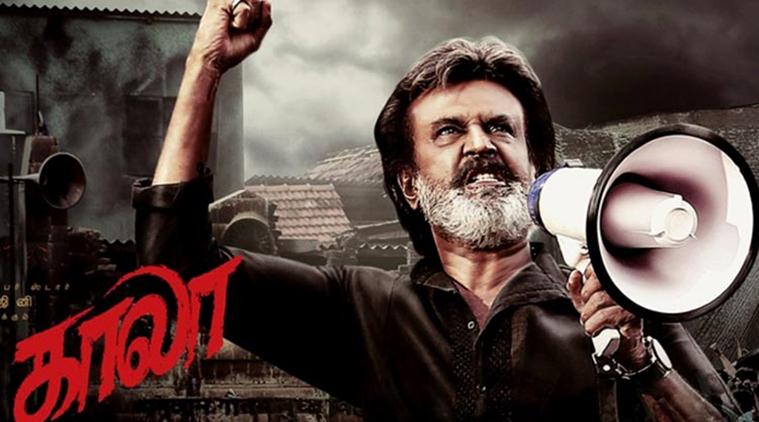Kaala: The dark knight
Rajinikanth's ‘Kaala’ is a political film that mirrors the social and economic questions of our time.

As Kaala, Rajinikanth plays a leader of slum-dwellers, who challenges the relentless displacement of the poor in a metropolis.
The first mass entertainer that explored the Tamil sub-society in Dharavi was Mani Ratnam’s Nayakan in 1987. The nayakan (hero) was Velu Naicker, played by Kamal Haasan, who arrives in Bombay as a child, fugitive from the law — “I killed a person,” he tells the Tamil boy who comes to his aid in the dark city. Shaktivel grows up to become the petty smuggler, Velu, and the equally loved and dreaded don, Velu Naicker. Mani Ratnam tells a nuanced tale about the making and prospering of the underclass don and hints at the links between the political class and the underworld. But it refused to engage head-on with the political economy that sustains these links.
The Dharavi of Nayakan is a microcosm of the underworld, a society of smugglers, petty thieves, prostitution, and other criminal activity; the only production in Nayakan’s slum is crime. Its inhabitants are caste-less, but subservient to mainstream Hinduism and its structures of power. When his rebellious daughter asks, can’t he chose another way of life, Naicker explains that there is no other way for him. This is the way he has survived in life and this is the only way he knows to survive. It is no defence of what he does or has done, but a resigned approach to a social order that turned him into a “rowdy”. The haunting tune reminds viewers at crucial moments in the film that Velu is a victim of circumstances, he could have grown into a gentrified Naicker in his homeland but for an act of crime he was forced into. In the southern realm of the Pandiyas/ In the streets where chariots race/ He was running along like a fawn/ Who could have hurt him? — as the song goes.
Three decades later, Tamil cinema returns to Dharavi with Kaala, which is all that Nayakan was not. The hero, Kaala or Karikalan, traces his roots to the same region that Velu Naicker came from. But their perspectives of life are radically different. And that isn’t just because 30 years separates the two films, but is also possibly the difference between the gaze of a Naicker, a dominant caste, and a Dalit. If Mani Ratnam strove hard to stay off class and caste realities that underpin the political economy, Pa Ranjith, the director of Kaala, is focussed on them.
Unlike Nayakan, which sought the epic narrative form and affirmed middle-class notions of virtue and societal behaviour, Kaala is a folksy celebration of Dharavi’s working class lives. Kaala is not apologetic or resigned to his life as “rowdy”, when challenged by his son (Lenin), who aspires to a life of planned modernity by combining class politics and NGO activism. Kaala recognises the blood and sweat of labour in the dirt of the slum, which also is the fuel that runs the urban economy. In fact, he inverts the idea of a rowdy and makes the case to see the predatory urban elite, who steals the land and labour of the slum resident, as the rowdy. He marks out the politician, the villain of the piece, who wants a war against dirt, as a parasite that wants to feeds off the labour of the working class. He throws a potent question at his son: When did the rich ever want to take care of the poor? Kaala is unambiguously clear that he may be poor but has agency which he will assert, not just individually but collectively as well.
Kaala is marketed as a Rajinikanth-starrer. But the star is incidental to the film, the real hero is the idea of Dalit/underclass/Tamil/Black assertion and the resistance that it espouses. The politics underwritten into Kaala’s aesthetics has at least four stands: One, the Ambedkarite vision of social equality; two, the idea of Dharavi/”slum” as a centre of labour and economic production; three, the Tamil nationalist project based on the binary of Aryan versus Dravidian, Ram versus Ravan; four, an anti-racist politics that celebrates black over white. All four seamlessly blend with the carefully chosen symbols — the numerous references to Ambedkar, including the portraits and the number plate of Kaala’s jeep, which recalls Babasaheb’s conversion to Buddhism, the name Kaala (after the subaltern deity, Kaala saami, invoking the great Chola emperor, Karikalan, the black colour) — and propose a radical agenda far removed from the populist and shallow Dravidian subnationalism that currently dominates Tamil politics.
Between the time Nayakan and Kaala were made, so much changed in society as well. The consensus regarding social justice and political empowerment claimed by the Dravidian Movement has come under challenge with the politicisation of the large Dalit population in the state. Caste violence against the Dalits in rural Tamil Nadu is mostly carried out by middle castes and OBCs, with the state, not surprisingly, taking sides with the latter. The revival of Ambedkarite thought since the 1990s has led to a cultural renaissance and political resurgence among the Dalits. The production of magazines and books and militant political action by Dalit parties like Viduthalai Chiruthaigal Katchi and Puthiya Tamizhagam has started to influence the contours of public discourse.
Ranjith is a product of this renaissance and Kaala, which builds on his previous work, is the sharpest articulation of the new Dalit politics. Kaala doesn’t reject Periyar E V Ramaswamy’s legacy — the black attire, for instance, recalls Dravida Kazhagam activists — but suggests the need to go beyond mere tropes of identity and explore new ideas to address new challenges.
Educate and agitate is the new slogan. After Kaala has been shot, a woman resident refutes that he is dead and tells the TV reporter that he (Kaala) was spotted outside the Buddha temple the other day. Kaala heralds a new Ambedkarite politics that is aware of the agency of Dalits not merely as Dalits but also the vanguard of the working class and acutely conscious of the land question in the urban political economy.
amrith.lal@expressindia.com
For all the latest Opinion News, download Indian Express App
More From Amrith Lal
- ‘Hindus have to come out and say: not in our religion’s name’Why Malayalam novelist KP Ramanunni undertook a penance for the Kathua gangrape in a Kerala temple. According to him, it was his response as a…
- Reading literature in many tongues: The story of his landThakazhi, a social realist, believed that the role of a novelist was to capture the sights and sounds of the world around him...
- AR Venkatachalapathy says Subramania Bharati has become a posthumous bestsellerAR Venkatachalapathy on the enduring magic of Subramania Bharati. ..








































No hay comentarios:
Publicar un comentario